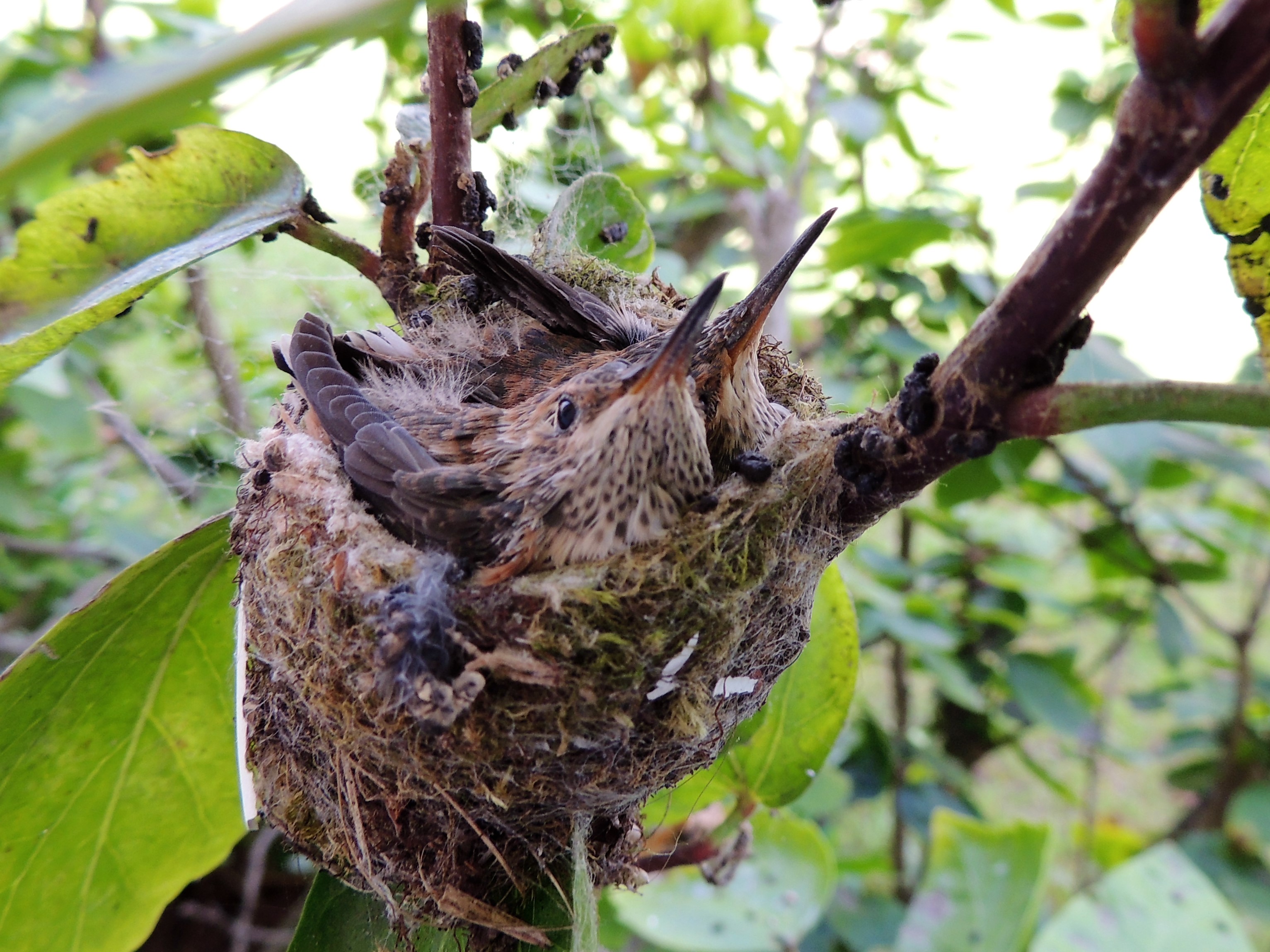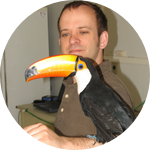About This Project
Hummingbirds use energy at extremely high rates due to their small size and high metabolism. They must conserve energy by going into nightly torpor, drastically dropping their metabolic rate and body temperature. We aim to quantify the energetics associated with nesting female hummingbirds using thermal imaging. We predict that in order to incubate their eggs well, they will rarely use torpor. This has important implications for understanding how animals cope with extreme energetic requirements.
Ask the Scientists
Join The DiscussionWhat is the context of this research?
Hummingbirds are among the most beautiful, acrobatic and mysterious animals. To maintain their extremely high metabolism they must constantly feed on high-energy nectar in the day. But at night, they are restricted from feeding and must conserve energy. Many species do this by entering torpor (temporary hibernation) where body temperatures drop from 45°C/105°F to as low as 7°C/45°F. But in some environments and life stages hummingbirds use torpor inconsistently. Our question is: to what extent do nesting urban female hummingbirds use torpor? Hummingbirds are ubiquitous on our campus where we have videotaped four active nests for the duration of the nesting periods. This presents a perfect opportunity to study the nesting energetics of free-living hummingbirds in an urban environment.
What is the significance of this project?
Hummingbirds provide important benefits to humans such as pollination and biophilia. However, environmental factors that affect behaviors that lead to such services are largely unknown, and could be altered by climate change. Furthermore, hummingbirds are an optimal system to investigate the physiological mechanisms animals use to cope with extreme limitations. A better understanding of these mechanisms may have broader applications in medical technology. Such applications could address the necessity to reduce oxygen and food consumption during long-term space travel – perhaps a human version of torpor (see 2001: A Space Odyssey). Lastly, students at all levels of education, from elementary school to Ph.D. candidates, will benefit from learning and marveling at the science of hummingbirds.
What are the goals of the project?
We aim to describe the extent to which nesting female hummingbirds use torpor in an urban environment. We plan to use remote non-invasive temperature sensing technology to measure the relationships between hummingbird surface, nest, and ambient temperature. We will conduct tests to determine if surface temperature is a good proxy for internal body temperature, and the accuracy of thermal sensors for measuring nest and egg temperature. We will then monitor several active nests in order to determine the state of torpidity of the female. In developing simple and low cost methodologies, we hope to develop a model that will facilitate investigation of complex, theory-based scientific questions through citizen science and integration into secondary-level public school classrooms.
Budget
With your generous support, we will purchase equipment that is central to our ability to describe the thermal characteristics of hummingbird nesting behavior. We are currently in the process of consulting industry experts and sales persons to identify and purchase specific models of thermal sensing technology that will best suit our applications. In order to simultaneously monitor multiple nests, and to run a comparative analysis between nests in different micro-environments, we require funding to purchase multiple sensory and data logging units. In addition, we request funding for supportive accessories that are necessary for continuous in-field monitoring, including security and weatherproofing equipment, rechargeable batteries, and external power adapters. We are confident that with your support we will accomplish our goals.
Endorsed by
Meet the Team
Affiliates
Affiliates
Affiliates
Affiliates
Affiliates
Team Bio
Our team formed after Erich returned from a field assistantship with Anusha with a heightened interest in hummingbird physiology. At an ornithology conference we discussed our idea with Glenn who extensively uses thermal imaging. Pete, a long-time advisor of Erich, will help with the experimental design and will be the faculty mentor for numerous undergraduate field assistants. Maria is an educational specialist and will help incorporate K-12 students and teachers in our project.
Erich Eberts
I recently graduated from Loyola Marymount University, where I studied biology with an emphasis in ecology. As an undergraduate, my primary research projects included Photosynthetic Characterization of Invasive Plant Species in Los Angeles County, Predator (American Crow) Electrical Shock Aversion System for Endangered California Least Terns, and Urban Hummingbird Biodiversity and Behavior. After graduation, I spent three months in Ecuador working with Anusha Shankar on her hummingbird research, and backpacking in the Peruvian Andes. Upon my return, I was excited to continue my research in urban wildlife biology, and especially in hummingbird behavior and physiology, at the LMU Center for Urban Resilience, where I spent three years as an undergraduate researcher. As the CURes Research Fellow, I primarily guide and mentor 15 undergraduate researchers on their urban wildlife and social science research projects. I am excited to involve a number of these students with this project, since they will be instrumental in finding nests and gathering data, and because I hope it will inspire them to ask interesting research questions and to develop innovative ways to investigate them. I plan to pursue a Ph.D. in Ecology to further develop my interests and experience in avian physiological and behavioral ecology, and to continue this research project!
Peter J. Auger, Ph.D.
I am a Senior Research Scientist and Operations Manager at the Center for Urban Resilience (CURes) at Loyola Marymount University in Los Angeles, CA. My background is in field biology, ethology, and urban ecology, and I teach courses in those disciplines at LMU. I am currently leading a team of undergraduate researchers at our CURes Animal Behavior Lab, and one of the extraordinary animals we are studying is hummingbirds. I also conduct active wildlife research projects throughout New England, Southern California and Costa Rica and am delighted to be part of this research team studying torpor in hummingbirds. How animals like hummingbirds conserve energy could be directly transferred to many complex challenges, including figuring out how astronauts will be able to travel great distances in space. Torpor in hummingbirds could potentially be used as a way to put humans into a "temporary hibernation" to slow down their body processes during their long space journey to say ... Mars, Jupiter, or beyond!!
Anusha Shankar, PhD
I am a PhD candidate in Ecology and Evolution at Stony Brook University and a National Geographic Young Explorer. I study the strategies hummingbirds use to manage their energy budgets in a variety of habitats. With an understanding of these strategies and energy budgets, I hope to better understand how animals will cope with changing climates. Within my dissertation work and outside it, I enjoy mentoring students- I loved managing and mentoring a multinational team of 8 undergraduates-including Erich- in my last field season in Ecuador! For some fun facts on hummingbird energetics, you can see my National Geographic video here.
Maria Curley, M.Ed.
I am an Education Specialist at the Center for Urban Resilience (CURes) at Loyola Marymount University in Los Angeles, California. I work in partnership with the Center for Equity for English Learners (CEEL) at LMU to design high quality urban ecology science curriculum for LTELs, long-term English learners. One of our teaching modules is on hummingbirds and students are fascinated by them! We hope to involve students and teachers in this investigation by sharing our scientific methods and results. They too can design similar investigations on their school campuses. We are looking forward to having students of all ages join us in our exploration of how hummingbirds do or don't use torpor during the nesting season. We believe this investigation will inspire students to think of deeper questions such as, how do hummingbirds manage their 'energy budget' throughout the day, and how do humans impact their biological, physiological, and social processes?
Glenn J. Tattersall, PhD
I am a Professor of Biology at Brock University, Ontario, Canada. My background is in Comparative and Evolutionary Physiology and I teach in the fields of behaviour, physiology, evolution, and neuroscience. My research lab involves a team of PhD, MSc and undergraduate students (TattersallLab.com) and collaborators from Brasil, Galapagos, Ecuador, Australia, Japan, and the US. We are actively involved in studying thermal aspects of animal biology, and rely on the use of infrared thermal imaging, as a non-invasive method of assessing body surface temperatures, as a means to infer changes in peripheral blood flow, or to estimate evaporative cooling, or to model heat exchange, to name a few. As an imaging technique, the value of modern infrared thermography is its ability to produce a digitized image or high speed video rendering a thermal map of the scene in pseudo-colour. I have developed open-source tools for analysing thermal images and will provide training in interpreting these images as well as help in designing the experiments and assisting with interpreting the thermal data.
Additional Information

Project Backers
- 121Backers
- 102%Funded
- $5,026Total Donations
- $41.20Average Donation








